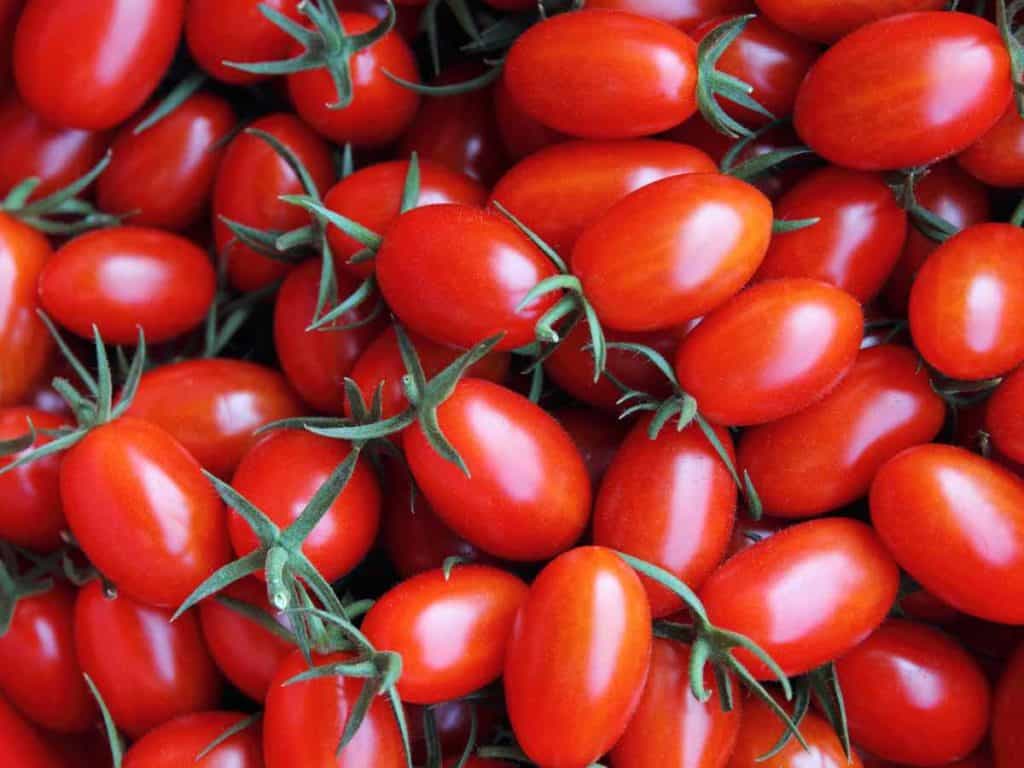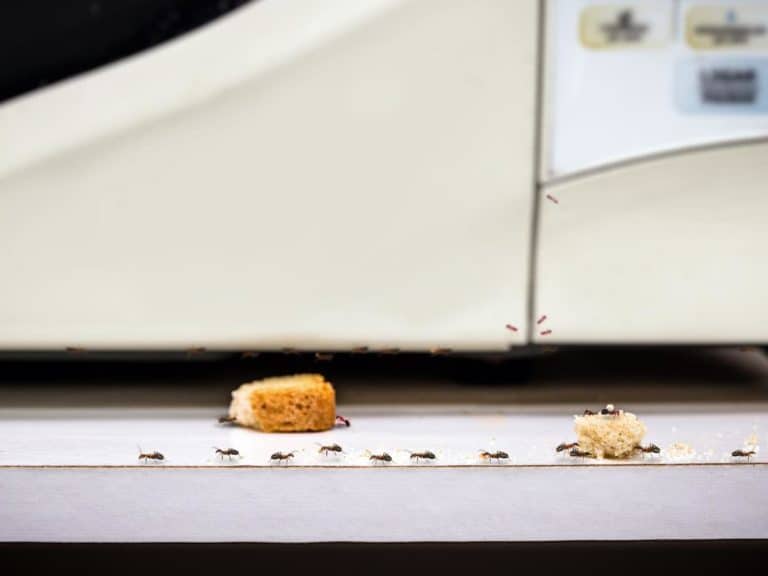Best Way to Store Grape Tomatoes
My Asian friend looked over my shoulder and laughed. “Oh, these look just like our native tomatoes back home! Just smaller!”
Turns out she was right. I’d purchased grape tomatoes, and it turns out this variety is indeed from Southeast Asia.
No, the tomatoes I’d bought weren’t imported. They were grown in Florida, but the original seed stock was sourced from Taiwan and Thailand.
My friend and I then got into a debate over how best to store the leftover grape tomatoes; she was of the ref school, being used to keeping veggies in the tropics, while I was of the refrigeration-ruins-tomatoes school.
The debate got us so worked up we ended up hitting the Internet together after dinner to find out the facts. That led to an interesting dive into the origins of tomatoes, and the discovery that I was wrong, though in a way we were both right.
The best way to store tomatoes depends on their ripeness and the ambient temperature.
Unripe grape tomatoes should be kept at room temperature until they ripen completely. After this, if it’s cool enough you can keep the tomatoes out, but if it’s warm it’s better to refrigerate them. Because grape tomatoes are sold ripe or almost ripe, they should be refrigerated after a day or two.
The grape tomatoes I’d bought worked perfectly for our salad that night and the (refrigerated) leftovers went very well on kababs a week later.
One friend who finds cherry tomatoes too watery appreciated the greater meatiness of the grape tomatoes, and we all agreed the flavor was different but close enough that we could use them in any recipe that called for cherry tomatoes.
Fun Facts About Grape Tomatoes You Possibly Didn’t Know

We’ve come a long way since the introduction of the tomato to Western palates.
Did you know there was a time many Europeans wouldn’t eat tomatoes? That was one of the fascinating things I found Googling the origins of the grape tomato.
When the Spaniards in Hernan Cortes’ Mexico expedition brought the first tomatoes Europeans had ever seen back to Spain, many saw the similarities between the tomato plant and poisonous nightshades like belladonna and foxglove.
For many years, Europeans particularly the Italians would grow tomatoes in their gardens, not as vegetables, but to admire their flowers. Turns out tomatoes have beautiful yellow flowers.
Who knew?
Whenever I think of tomatoes, I think of biting them, not admiring them!
Tomatoes didn’t get their toehold in Italian cooking until several decades after their introduction from Spain, though they were already much used in Spanish cuisine by then. As late as the 19th century, some Englishmen still believed the tomato poisonous and either avoided them or recommended minimizing intake of them.
Even the tomato’s scientific name given by Linnaeus, Lycopersicon, reflects this fear. Lycopersicon means wolf-peach, signifying luscious-looking fruit that is dangerous as a wolf.
Asia, though, seemed less finicky. The tomato was apparently a hit as soon as the Spaniards introduced them to their colony in the Philippines, from where it spread quickly to Indochina and the Malay archipelago.
It has gotten so entrenched in the local cuisines that my friend always assumed the plant was native to her country and was surprised it had originally come from Mexico.
There are Asian languages though that remember the tomato’s foreign origin.
In Chinese tomato is ‘fanqie,’ the ‘barbarian eggplant,’ and in Bengali it’s ‘biliti begun,’ the ‘foreign eggplant.’ Why eggplant? Because, like the European botanists, the Asian farmers had noticed the tomato’s similarity to eggplant, which is also of the nightshade family.
Is tomato poisonous, then, like other nightshades?
Not quite. While unripe potatoes and potato leaves, and eggplant leaves and flowers contain the toxin solanine, tomato plants mostly contain a much weaker substance called tomatine, and only very tiny amounts of solanine.
Both substances function as insect repellents, discouraging bugs from chowing down on the developing plants, fruits, and tubers.
Scientists have yet to study the toxicity of tomatine to humans, but it’s estimated to be so low in ripe tomatoes that you’d have to eat more tomatoes than your stomach can handle to get ill from it. However, it’s bad news to let your dog chew on your tomato plants since tomatine is concentrated enough in the green vines and leaves to harm dogs.
Fun fact: the first-ever tomato recipe ever found in the West was an Italian sauce recipe from the 1692 book Lo scalco alla moderna. It called for making a ‘Spanish style’ tomato sauce made of ‘tomatoes roasted until scorched in the embers’ and added to chopped onions, chili peppers, salt, oil (likely olive), and vinegar.
Thoughts of poisoning however did not stand in the way of the ‘barbarian eggplant’ in Asia, so it soon found its way into all sorts of curries, sauces, soups, and salads.
This led to the development of elongated tomato varieties in Southeast Asia, which became the ancestors of the grape tomato.
Growers in the United States first experimented with raising grape tomatoes in the 1990s, with one Florida farmer using a variety from Taiwan, and a Mexican farmer trying out a variety from Thailand, which was then introduced to the US.
The grape tomato was found to have several advantages over the cherry tomato for growers and retailers alike.
First, grape tomatoes, having been developed for the tropics, can fruit all year round. This is why you sometimes find mostly grape tomatoes in the salad veggies section during the winter months.
Second, grape tomatoes have thicker, stronger skin than cherry tomatoes. This makes them easier to ship and store, and gives them a longer shelf life. Third, the fruits were smaller and thus handier to use in salads.
Grape tomatoes are similar to Roma tomatoes in their meatiness and texture, though a little sweeter.
They are a bit more acidic than cherry tomatoes, with a more balanced flavor that some find more ‘tomato-ey’ and reminiscent of a summer garden. They can be used in any of the recipes calling for cherry tomatoes except for stuffed tomatoes because they’re smaller than cherry tomatoes.
Why Shouldn’t Tomatoes Be Refrigerated?
Tomatoes require a temperature between 65 to 75 F to ripen. At temperatures below 55 F, tomatoes stop ripening, and worse, experience ‘chilling injury.’ This causes them to develop a mealy texture and pitting, and they cease developing the compounds that give them their aroma and flavor. Refrigerators run at 35-40 F, below the safe range for chilling injury.
Yes, refrigerating tomatoes causes them to lose quality.
Yes, refrigerating tomatoes keeps them fresh longer.
Sounds confusing, doesn’t it? A closer look at the science behind these, however, shows that the best way to store tomatoes – whatever the variety — is a conditional thing.
However, in warm weather tomatoes can quickly go from fully ripe to overripe and rotting, in the tropics taking just a day or two during the hottest seasons.
Which way you should go is thus a question of how ripe your tomatoes are and what the weather or ambient temperature is like. Let’s look at some recommended practices for storing tomatoes, particularly grape tomatoes.
How To Store Grape Tomatoes
Grape tomatoes are more forgiving in handling because of their thicker skins, but since they’re sold ripe or nearly ripe they are best refrigerated soon after purchase. They are sold this way because grape tomatoes ripen best on the vine, and their skins are sturdy enough to stand shipping even when ripe.
Washing Tomatoes Before Storing
It is not recommended to wash any vegetables, including tomatoes, before storing them. This wetting can help molds and bacteria to grow on your vegetables, thus accelerating spoilage. Instead, wash your tomatoes just before eating or cooking them. There is no need to use soap, bleach, or any cleaner – just rinse, rub, then dry.
Never use any kind of cleaning chemical on tomatoes. The stem end of the tomato is porous, so any chemical you use to wash it can get into the tomato through there. To preserve safety and flavor, stick to washing with plain water.
How To Store Unripe Grape Tomatoes
If you got your grape tomatoes not yet fully ripened, you can let them ripen on your counter.
For best results, stack them away from direct sunlight, stem side down. The elongated grape tomatoes are a bit harder to put into a headstand than other tomatoes, though, so you can do so by packing them together tightly enough in a basket that they support each other.
Storing the tomatoes stem-side down helps their ripening and retains freshness in two ways. First, it prevents moisture from escaping the tomato through the porous stem tissue. Second, as long as you inverted the tomato over a clean surface, doing so keeps molds, bacteria, and fruit flies from getting into the tomato through the stem tissue.
If you want to accelerate the ripening process, you can wrap your tomatoes in a newspaper then leave them on the counter. Check each tomato every day for ripeness; they won’t all ripen at the same speed. Refrigerate the ripe ones immediately, and re-wrap the ones still on the way.
How To Store Whole Ripe Grape Tomatoes
Whole ripe grape tomatoes should be refrigerated. Place them in the refrigerator’s vegetable compartment in a single layer, stem side up. At this point, you don’t want the tomatoes to continue ripening, because if they do you’ll end up with mushy overripe tomatoes.
Because of this, you also want to avoid storing ripe tomatoes, especially small ones like grape tomatoes, inside the same compartment as fruits that produce plenty of ethylene. This includes apples, avocados, bananas, apricots, pears, and mangoes. Bananas are particularly heavy ethylene producers.
Whole ripe grape tomatoes will last up to 5 days in the fridge.
How To Store Cut Grape Tomatoes
Cut tomatoes will of course spoil much faster than whole tomatoes, and are a tempting target for fruit flies. As much as possible you don’t want to store cut tomatoes.
However, if you end up cutting more than you need for a salad or something, place them cut side down in a single layer inside a sealable food keeper and refrigerate them. Use cut tomatoes within 1-2 days for best quality.
What To Do With Leftover Grape Tomatoes
If you end up with way more grape tomatoes than you need, consider making some kind of sauce or preserve with them to extend their shelf life. You can make tomato sauces, roasted tomato sauces, or tomato chutneys, all of which last longer because they’ve been cooked, and tomato sauces can be frozen.
Can Grape Tomatoes Be Frozen?
You can freeze grape tomatoes to make them last longer. However, they will no longer be good for salads as freezing will both turn their texture mushy and reduce flavor. Freezing grape tomatoes, or any kind of tomato, is recommended only when you have a lot more tomatoes than you can use and want to keep the leftovers for use in cooking.
To freeze whole grape tomatoes:
- Inspect the tomatoes and throw away any spoiled ones
- Rinse the whole tomatoes under running water, then dry them on paper towels
- Cut away the stem scar
- Arrange the tomatoes on cookie sheets and place them in the freezer until frozen solid
- Transfer the frozen tomatoes to ziplock bags or other airtight containers
If you have the time, however, it is better to freeze cooked tomatoes than to freeze them raw so try making a sauce or preserve. Ready-to-reheat sauces can save you a lot of time when you need to make dinner in a hurry.
How To Tell If Grape Tomatoes Have Gone Bad
All tomatoes can spoil rather easily, and biting into a rotten tomato while enjoying your salad can really ruin a meal. Avoid this bad experience by checking your tomatoes visually, by feel, and by odor before you use them.
If you find any signs of spoilage in your tomatoes, discard the spoiled ones and double-check the rest as spoilage tends to spread quickly among tomatoes kept together.
Visual signs of spoiled tomatoes
Spoiled tomatoes can have dark or green spots or sometimes fuzzy white growths from mold, or leak fluid. Also do not risk eating tomatoes with cracked skin, as bacteria may have entered these already.
Feel of spoiled tomatoes
Spoiled tomatoes feel very soft and mushy, and will give off fluid at the lightest pressure from breaks in the skin or from around the stem scar.
The odor of spoiled tomatoes
Spoiled tomatoes will have a bitter or sour odor.
If in doubt, slice a suspect tomato in half and feel the insides. If the pulp containing the seeds feels slimy, the tomato has gone bad.
Read Also: How to Store Oranges Properly Long and Short Term





